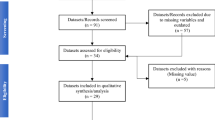Abstract
This study investigated risk factors associated with the type of birth attendants and timing of postnatal care among a nationally representative sample of Nepalese women. The 2006 Nepalese Demographic and Health Survey on women age 15–49 years old who had delivered within 3 years prior to the survey (N = 4,136) was used. Multivariate logistic regression was employed to study the association between socio-demographic variables and type of birth attendants and timing of postnatal care. Only 23 % deliveries were assisted by skilled attendants. A majority of Nepalese women did not have postnatal check-ups. Education (OR = 1.46, 95 % CI = 1.11–1.92), wealth (OR = 2.57, 95 % CI = 1.59–4.15) and sufficiency of advice during pregnancy (OR = 3.09, 95 % CI = 2.16–4.41), were all independently associated with having postnatal check-ups. Similarly, maternal age, education, parity, wealth, sufficiency of advice and place of delivery were associated with having delivery assisted by a skilled attendant. The utilization of postnatal services is still very low in Nepal. Public health interventions are needed to increase the utilization of postnatal care as well as delivery assisted by skilled attendants. Such interventions should target poor women, the less educated and those in rural areas in Nepal.
Similar content being viewed by others
References
World Health Organization (WHO). (2000). Maternal mortality in 2000. Geneva: Estimates developed by WHO, UNICEF and UNFPA, WHO.
Nepal demographic and Health Survey (NDHS). (2006). Ministry of Health and Population Government of Nepal. USA: New ERA Kathmandu Nepal and Macro International Inc. 2007.
Dhakal, S., Chapman, G. N., Simkhada, P. P., van Teijlingen, E. R., Stephens, J., & Raja, A. E. (2007). Utilization of postnatal care among rural women in Nepal. BMC Pregnancy & Childbirth, 7, 19.
Rahman, M., Haque, S. E., & Zahan, S. (2011). Factors affecting the utilization of postpartum care among young mothers in Bangladesh. Health and Social Care in the Community, 19(2), 138–147.
Matsumura, M., & Gubhaju, B. (2001). Women’s status, household structure and utilization of maternal health services in Nepal. Asia Pacific Population Journal, 16(1), 23–43.
Neupane, S., & Doku, D. (2012). Determinants of time of start of prenatal care and number of prenatal care visits during pregnancy among Nepalese women. Journal of Community Health, 37, 865–873.
Joshi, N., Agho, K. E., Dibley, M. J., Senarath, U., & Tiwari, K. (2012). Determinants of inappropriate complementary feeding practices in young children in Nepal: Secondary data analysis of Demographic and Health Survey 2006. Maternal & Child Nutrition, 8(1), 45–59.
Districts of Nepal. Indicators of development update (2003). International centre for integrated mountain development (ICIMOD), Kathmandu, Nepal.
Mpembeni, R. M. N., Killewo, J. Z., Leshabri, M. T., Siriel, N., Massawe, S. N., Jahn, A., et al. (2007). Use pattern of maternal health services and determinants of skilled care during delivery in Southern Tanzania: Implications for achievement of MDG-5 targets. BMC Pregnancy & Childbirth, 7, 29.
Ikamari, L. D. E. (2004). Maternal health care utilization in Teso District. African Journal of Health Sciences, 11, 21–32.
Chakraborty, N., Islam, M. A., Chowdhury, R. I., & Bari, W. (2002). Utilization of postnatal care in Bangladesh: Evidence from a longitudinal study. Health and Social Care in Community, 10(6), 492–502.
Pebley, A. R., Goldman, N., & Rodriguez, G. (1996). Prenatal and delivery care and childhood immunization in Guatemala: Do family and community matters? Demography, 33, 231–247.
Ochako, R., Fotso, J. C., Ikamari, L., & Khasakhala, A. (2011). Utilization of maternal health services among young women in Kenya: Insights from the Kenya Demographic and Health Survey, 2003. BMC Pregnancy & Childbirth, 11, 1.
Prince, M. R. (1999). Maternal health services and women’s education. The independent, August 6.
Paul, B. K., & Rumsey, D. J. (2002). Utilization of health facilities and trained birth attendants for childbirth in rural Bangladesh: An empirical study. Social Science and Medicine, 54, 1755–1765.
Wong, E. L., Popkin, B. M., Gullkey, D. K., & Akin, J. S. (1987). Accessibility, quality of care and prenatal care use in the Philippines. Social Science and Medicine, 24, 927–944.
Bhatia, J. C., & Cleland, J. (1995). Determinants of maternal care in a region of South India. Health Transition Review, 5, 127–142.
Elo, T. I. (1992). Utilization of maternal health-care services in Peru: the role of women’s education. Health Transition Review, 2, 49–69.
Bhatia, J. C. (1993). Levels and causes of maternal mortality in Southern India. Studies in Family Planning, 24, 310–318.
Garenne, M., Mbaye, K., Bah, M. D., & Correa, P. (1997). Risk factors for maternal mortality: A case control study in Dakar hospitals (Senegal). African Journal of Reproductive Health, 1, 14–24.
van Eijk, M. A., Bles, M. H., Odhiambo, F., Ayisi, G. J., Blokland, E. I., Rosen, H. D., et al. (2006). Use of antenatal and delivery care among women in rural western Kenya: a community based survey. Reproductive Health, 3, 2.
World Health Organization (WHO). (2004). Country health profile Nepal WHO, Regional Office for South-East Asia.
Author information
Authors and Affiliations
Corresponding author
Rights and permissions
About this article
Cite this article
Neupane, S., Doku, D. Utilization of Postnatal Care Among Nepalese Women. Matern Child Health J 17, 1922–1930 (2013). https://doi.org/10.1007/s10995-012-1218-1
Published:
Issue Date:
DOI: https://doi.org/10.1007/s10995-012-1218-1



